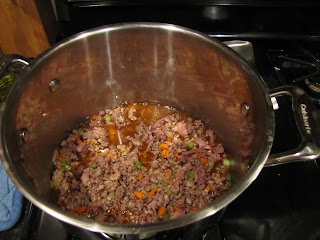I promised to post recipes from last weekend's Christmas party. I'm not going to be able to post all of them, because I didn't cook all of the dishes (we had many contributors to the dinner), but I will post two- French baguettes and spinach stuffed squash.
Also, I received the half sphere molds for the yogurt charolettes for the French Laundry blueberry soup, so I will be posting that recipe in the very near future. I will be taking off work the first week of January, and I plan to do quite a bit of cooking and writing during that time.
----
French Baguettes
4 cups white bread flour
1 1/2 teaspoon salt
1 1/2 teaspoon active dry yeast
1 1/3 cups warm water (100-110 degrees F)
Olive oil
Stir the flour and salt together in a large bowl, then add the yeast. Make a well in the center and add the water. Make sure the water is warm (100-110 degrees F), too hot or cold and it can kill the yeast.
Mix together the ingredients with a spoon until the dough starts to stick together, then knead the dough with your hands until it leaves the sides of the bowl and comes together. To prevent dough from sticking to your hands too much, rub flour on them before touching the dough.
Turn the dough out onto a lightly floured work surface (clean counter or large cutting board) and knead it for several minutes until it is smooth. Be careful not too work the dough too much. The less you work it, the lighter it will be.
Cover the inside of a large bowl with a thin layer of oil, shape the dough into a ball, and place in the bowl. Cover the bowl with a damp towel or plastic wrap, and place in a warm area for roughly an hour, until it is nearly doubled in size. I like to warm my oven up to about 175 degrees F, then turn it off about a half hour prior. This will keep it relatively warm, and is a good place to keep the dough so it can rise.
After an hour or so, turn the dough out onto your cleaned, lightly floured work surface again, and knead it briefly. Cut it in half and shape the pieces into two balls. With your hands, work each piece into a rough rectangle measuring 7-8 inches long by 2-3 inches wide. Roll each piece lengthwise, folding it roughly 3 times into it starts to take the shape of a baguette. Place the dough on a cookie sheet, cover with a damp cloth of plastic wrap, and place in a warm place to rise for 10-15 minutes. You will need to do this twice more, each time repeating the folding and rising.
The final time you fold the dough, stretch it to approximately 12-14 inches in length., and fold it into the shape of a baguette Cut deep slits in the top of the loaf. Let the dough sit for another half hour in a warm place.
Heat the oven to 450 degrees F. Place the loaves in the oven, as well as another cookie sheet with water in it on the rack below the loaves. The water will help keep the crust of the bread from becoming too crispy. Bake for 15-18 minutes. Remove from oven, cool on wire racks, and brush with olive oil.
I like to keep the loaves in tin foil when not serving them.
----
Spinach Stuffed Squash
4 large yellow squash
1 1/2 teaspoon salt
1/4 cup butter
1/2 cup grated fresh Parmesan cheese
1/4 teaspoon pepper
1 small onion, chopped
2 (10 oz) package frozen chopped spinach, cooked and well drained
1 cup sour cream
2 teaspoon red wine vinegar
1/4 cup fine, dry bread crumbs
1 tablespoon cold butter, cut up
Combine squash, 1/2 teaspoon salt and water to cover in a large pot. Bring to a boil and cook until tender, 10-20 minutes. Remove the squash from the water and allow them to cool.
Cut the squash in half lengthwise and remove the seeds. Drizzle the cut sides of squash with 2 tablespoons melted butter. Sprinkle with 2 tablespoon Parmesan, 1/2 teaspoon salt and pepper.
Pour remaining 2 teaspoon melted butter in a large skillet over medium high heat and add onions. Sauté the onions until tender, roughly 4-5 minutes.
Stir in cooked spinach, sour cream, red wine vinegar and remaining 1/2 teaspoon salt.
Spoon spinach mixture evenly into squash halves. Place squash in a 13” x 9” baking dish. Sprinkle with bread crumbs and remaining 6 tablespoons cheese and cold butter.
Sorry, I don't have pictures of the stuffed squash. But try out the recipe, I'm sure you'll like the results.
----
Also, I'm very happy to have received several awesome food related Christmas presents: A food grinder attachment for my Kitchenaid mixer, a cast iron dutch oven, The Flavor Bible and Culinary Artistry, both by Andrew Dornenburg and Karen Page, and a massive, Wusthof 10" chef's knife with an extra wide blade. I can't tell you how awesome this knife is. It cuts through anything like butter, and is HEAVY.
Here it is next to a regular 8" chef's knife for comparison.
----
Well that's it for today. Happy Holidays and Merry Christmas everyone!


















































